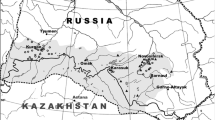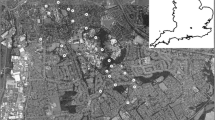Abstract
A number of rare butterflies are known to only utilise their host plant species when they grow in particular situations. Field data are presented showing that two rare species of aphid also only utilised their host plants when they grew in particular situations, namely near ant nests. The oak-feeding aphid Stomaphis quercus only occupied trees within 17 m of a Lasius fulignosus nest. The thyme-feeding aphid Aphis serpylli only occurred in a region of a Breckland grass heath where the sward contained a high density of Lasius niger nests, and then most commonly only in quadrats containing ant nests. The sward that was suitable for A. serpylli was generated by the action of farm traffic. It is concluded that ants indirectly impose habitat specificity on these aphids.
Similar content being viewed by others
References
Adams, D.C. and Anthony, C.D. (1996) Using randomization techniques to analyse behavioural data. Anim. Behav. 51, 733–8.
Barrett, K.E.J. (1979) Provisional Atlas of the Insects of the British Isles. Part 5. Hymenoptera: Formicidae. Huntington, UK: Biological Records Centre.
Blackman, R.L. and Eastop, V.E. (1994) Aphids on the World's Trees. Oxford: CAB International.
Boomsma, J.J. and De Vries, A. (1980) Ant species distribution in a sandy coastal plain. Ecol. Entomol. 5, 189–204.
Brian, M.V. (1964) Ant distribution in a southern England heath. J. Anim. Ecol. 33, 451–61.
Brian, M.V. (1977) The New Naturalist, Ants. London: Collins.
Brian, M.V., Hibble J. and Stradling D.J. (1965) Ant pattern and density in a southern English heath. J. Anim. Ecol. 34, 545–55.
Brian, M.V., Mountford, M.D., Abbott, A. and Vincent, S. (1976) The changes in ant species distribution during ten years post-fire regeneration of a heath. J. Anim. Ecol. 45, 115–33.
Buckley, R. (1987) Ant-plant-Homopteran interactions. Adv. Ecol. Res. 16, 53–85.
Dixon, A.F.G. and Kindlmann, P. (1990) Role of plant abundance in determining the abundance of herbivorous insects. Oecologia 83, 281–3.
Dolman, P.M. and Land, R. (1995) Lowland heathland. In Managing Habitats for Conservation (W.J. Sutherland and D.A. Hill, eds), pp. 267–91. Cambridge: Cambridge University Press.
Dolman, P. and Sutherland, W. (1991) Historical clues to conservation. New Scientist 129 (12 January), 40–3.
Dolman, P.M. and Sutherland, W.J. (1992) The ecological changes f Breckland grass heaths and the consequences of management. J. Appl. Ecol. 29, 402–13.
Dolman, P.M. and Sutherland, W.J. (1994) The use of soil disturbance in the management of Breckland grass heaths for nature conservation. J. Env. Manag. 41, 123–40.
Doncaster, C.P. (1981) The spatial distribution of ants' nests on Ramsey Island, South Wales. J. Anim. Ecol. 50, 195–218.
Donisthorpe, H.St.J.K. (1927) British Ants. London: George Routledge and Son.
Elmes, G.W. and Thomas, J.A. (1992) Complexity of species conservation in managed habitats - interactions between Maculinea butterflies and their ant hosts. Biodivers. & Conserv. 1, 155–69.
Elmes, G.W. and Wardlaw, J.C. (1982) A poulation study of the ants Myrmica sabuleti and Myrmica scabrinodis living at two sites in the south of England. II. Effect of above-nest vegetation. J. Anim. Ecol. 51, 665–80.
Fry, R. and Lonsdale, D. (1991) Habitat Conservation for Insects - a Neglected Green Issue. Middlesex, U.K.: Amateur Entomologists' Society.
Gallé, L. (1991) Structure and succession of ant assemblages in a north European sand dune area. Holarc. Ecol. 14, 31–7.
Goidanich, A. (1957) Le migrazioni coatte mirmecogene dello Stomaphis quercus Linnaeus afide olociclico monocio omotopo. Boll. Entom. Bolgna 23, 8–131.
Hassall, M. (1996) Spatial variation in favourability of a grass heath as a habitat for woodlice (Isopoda: Oniscidea). Pedobiologia 40, 514–28.
Heie, O.E. (1986) Fauna Entomologica Scandinavica. Volume 17. The Aphidoidea (Hemiptera) of Fennoscadia and Denmark. III. Family Aphididae: subfamily Pterocommatinae and tribe Aphidini of subfamily Aphidinae. E.J. Brill/Scandinavian Science Press, Leiden.
Heie, O.E. (1995) Fauna Entomologica Scandinavica. Volume 31. The Aphidoidea (Hemiptera) of Fennoscandia and Denmark. VI. Family Aphididae: Part 3 of tribe Macrosiphini of subfamily Aphidinae, and family Lachnidae. E.J. Brill, Leiden.
Jordano, D., Rodriguez, J., Thomas, C.D. and Fernàndez Haeger, J. (1992) The distribution and density of a lycaenid butterfly in relation to Lasius ants. Oecologia 91, 439–46.
Lorenz, H. and Scheurer, S. (1997) Biology and generationorder of Stomaphis quercus (L.) (Sternorrhyncha, Lachnidae) living on Betula pendula Roth near Berlin/Germany. Fifth International Symposium on Aphids. Program Abstracts, p. 40. Leon, Spain: University of Leon.
McLean, I.F.G. (1988) A second British locality for Aphis mammulata Gimmingham and Hille Ris Lambers (Homoptera: Aphididae). British Journal of Entomology and Natural History 1, 188–9.
McLean, I.F.G. (1992) The extinction of a population of Aphis mammulata Gimmingham. British Journal of Entomology and Natural History 5, 183–4.
Piggott, C.D. (1955) Biological flora of the British Isles. Thymus L. J. Ecol. 43, 365–87.
Pontin, A.J. (1960) Field experiments on colony foundation by Lasius niger (L.) and L. flavus (F.) (Hym., Formicidae). Insectes Soc. 7, 227–30.
Pontin, A.J. (1961) Population stabilization and competition between the ants Lasius flavus (F.) and L. niger (L.). J. Anim. Ecol. 30, 47–54.
Pontin, J. (1996) Ant nests, sun and shade - their measurement and significance for invertebrate conservation. British Wildlife 8, 21–7.
Quinet, Y. and Pasteels, J.M. (1995) Trail following and stowaway behaviour of the myrmecophilous staphylinid beetle, Homoeusa acuminata, during foraging trips of its host Lasius fuliginosus (Hymenoptera, Formicidae). Insectes Soc. 42, 31–44.
Ratcliffe, D.A. (1977) A Nature Conservation Review. Volume 2: Site Accounts. Cambridge: Cambridge University Press.
Ravenscroft, N.O.M. and Young, M.R. (1996) Habitat specificity, restricted range and metapopulation persistence of the slender scotch burnet moth Zygaena loti in western Scotland. J. Appl. Ecol. 33, 993–1000.
Rodwell, J.S. (1992) British Plant Communities. Volume 3. Grasslands and Montane Communities. Cambridge: Cambridge University Press.
Stace, C.A. (1997) New Flora of the British Isles. Cambridge: Cambridge University Press.
Stroyan, H.L.G. (1984) Handbooks for the identification of British insects. Vol.2, part 6. Aphids - Pterocommatinae and Aphidinae (Aphidini). London: Royal Entomological Society.
Thomas, J. (1979) Why did the large blue become extinct in Britain? Oryx 15, 243–7.
Thomas, J.A. (1991) Rare species conservation: case studies of European butterflies. In The Scientific Management of Temperate Communities for Conservation (I.F. Spellberg, F.B. Goldsmith and M.G. Morris, eds), pp. 149–97. Oxford: Blackwell.
Thomas, J.A. (1993) Holocene climate changes and warm man-made refugia may explain why a sixth of British butterflies possess unnatural early-successional habitats. Ecography 16, 278–84.
Thomas, J.A., Thomas, C.D., Simcox, D.J. and Clarke, R.T. (1986) Ecology and declining status of the silver-spotted skipper butterfly (Hesperia comma) in Britain. J. Appl. Ecol. 23, 365–80.
Watt, A.S. (1940) Studies in the ecology of Breckland IV. The grass-heath. J. Ecol. 28, 42–70.
Zar, J.H. (1984) Biostatistical Analysis. London: Prentice-Hall.
Author information
Authors and Affiliations
Rights and permissions
About this article
Cite this article
Hopkins, G., Thacker, J. Ants and Habitat Specificity in Aphids. Journal of Insect Conservation 3, 25–31 (1999). https://doi.org/10.1023/A:1009626405307
Issue Date:
DOI: https://doi.org/10.1023/A:1009626405307




